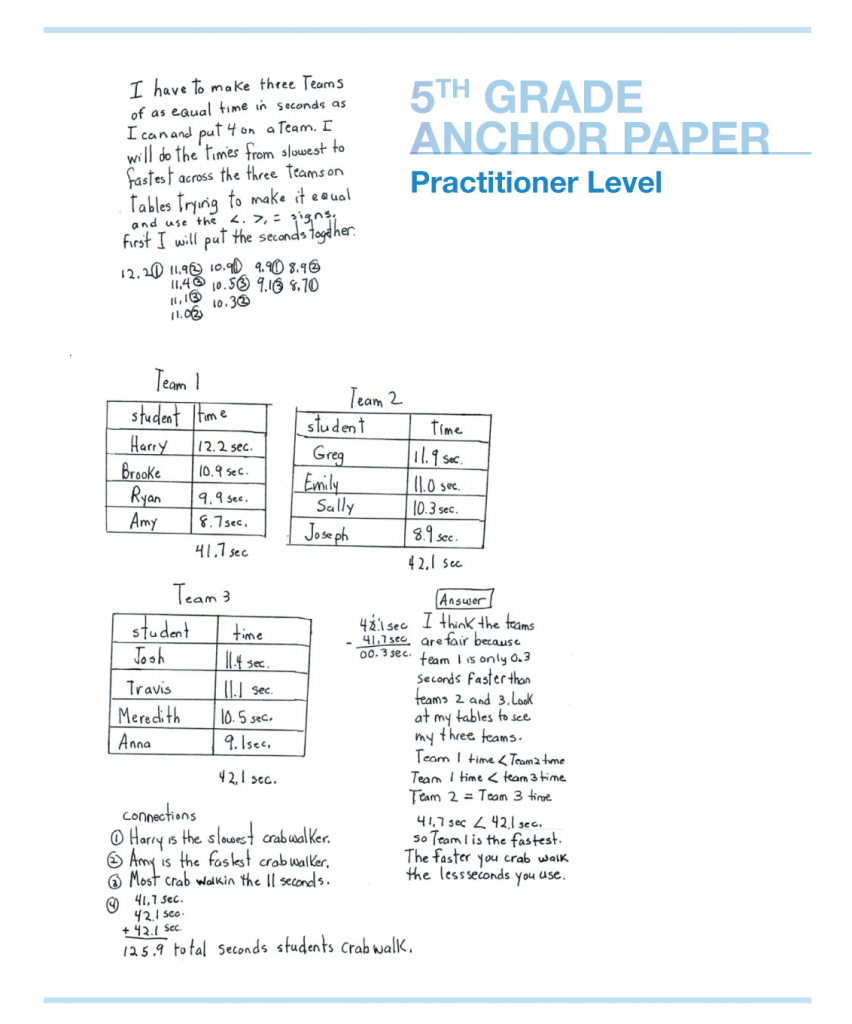When Teacher Candidates “Do the Math” With Exemplars

This blog is a reflection written by Dr. Courtney Baker, Ph.D., an Assistant Professor in Math Education Leadership at George Mason University, on her use of Exemplars with her elementary teacher candidates. The findings outlined in this piece would be beneficial to other professional development courses in a school or district setting.
Exploring Exemplars
Promoting discourse from rich tasks that move mathematical thinking forward challenges elementary teacher candidates, as their past experiences in working with both mathematics and children is often limited.
In teaching practice, the ability to come up with alternative approaches that vary from the traditional algorithm is necessary in order to anticipate student responses and to plan appropriate instructional opportunities. For new teacher candidates, however, this can represent a significant hurdle. Last semester, I incorporated resources from Exemplars into my practice to support my students with developing the background knowledge required to successfully anticipate student responses.
Upon my initial exploration of the Exemplars Library I was intrigued. How could I use these resources to not only introduce how children might authentically approach a particular problem, but also to elicit discussions centered on mathematics content? To meet these objectives, I needed to find a rich task that promoted a deep understanding of the pedagogical and content knowledge required to teach elementary mathematics. After looking through the expansive Library, I realized that multiple tasks met my needs as an instructor. I decided on a fifth-grade task titled “Crab Walk Relay Race.”
Doing the Math
I handed the pre-service teachers in my class hard copies of the corresponding overhead and created small groups to “do the math” collaboratively. I asked them to think about possible approaches using multiple representations (concrete, pictorial, and abstract) as well as possible student misconceptions. I wanted the teacher candidates to anticipate how a student might approach the task. I also wanted them to think critically about the manipulatives that would prove beneficial. My hope was for the teacher candidates to apply the knowledge gained from both their readings and fieldwork as they explored the Exemplars task. What happened in class, exceeded my expectations.
What started out as a 25-30 minute activity became a 60+ minute experience. Grounded in authenticity, the task promoted conversations that connected the teacher candidates’ background experiences with problem solving. Specifically, many of my students shared connections to either coaching sports teams or creating similar environments with children.
My class explained their strategies to one another as they tested their hypotheses. While they searched for an efficient strategy, they constantly compared their thinking to ensure that they were creating the most equitable teams. This continual communication allowed teacher candidates to share their thinking while using mathematically rich vocabulary.
Connecting to the Curriculum
After each group anticipated how students might approach the task, I provided them with the corresponding Exemplars Preliminary Planning Sheet. This resource proved to be an amazing support in the exploration of the mathematics content. Due to their limited experience with the standards, these pre-service teachers previously struggled to find connections between rich tasks and state standards. However, with the support of this document, my students were able to clearly articulate which mathematics standards the task was aligned with.
Analyzing Anchor Papers as Student Work Samples
At the heart of my activity was the analysis of student work samples. I took the levels (Novice, Apprentice, Practitioner and Expert) off of each anchor paper, and provided all samples to each group for evaluation. Initially, I thought that without the labels the teacher candidates would easily be able to sort and classify the student work samples. While I knew the discussion would center on determining what exactly each student knew, what I did not expect was the rich discussion that followed.
Teacher candidates were amazed at the variety of ways a student could approach the problem (many of which they had not anticipated). While some papers were easy to score, others were more challenging. Additionally, the anchor papers provided guidance to the depth of knowledge required to be identified as a successful problem solver. Their discussions centered on questions such as:
- How do we define the difference between a student who is an Apprentice and one who is a Practitioner?
- What questions could we ask the student to help them explain their thinking to us?
- To what extent must a student display their knowledge to be identified as an Expert problem solver?
- Is it possible for a student to identify a correct solution, but not be an Expert problem solver?
These questions arose organically from the use of this Exemplars task, and pushed my students’ understanding of problem solving.

Supporting Teacher Development
Preparing individuals to effectively teach elementary mathematics is a challenge, as it is impossible to provide each teacher candidate with all the knowledge and resources required to effectively teach elementary mathematics. Looking at how students might authentically approach a problem is essential for teachers to further their practice. Incorporating the Exemplars task into my teaching allowed teacher candidates to critically reflect on their practice and predict how students might approach problems through the analysis of these materials.
Sharing this Exemplars task with my students made for a great discussion that furthered their understanding of teaching elementary mathematics, and highlighted the complexities of problem solving. It also provided teacher candidates with a quality resource that they can potentially access as they enter into classrooms of their own.

